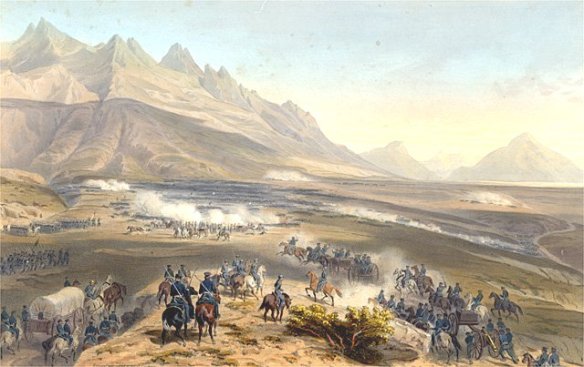Battle of Buena Vista during the Mexican-American War, painting by Carl Nebel.
Santa Anna had an army of twenty thousand based at San Luis Potosi, located about 250 miles south of Saltillo, which Taylor’s forces had occupied in November 1846. When a U. S. letter was intercepted, Santa Anna learned about Scott’s attack plan and also that Taylor’s troops had been reduced. Hungry for a victory in northeastern Mexico before he turned his attention to Scott’s planned invasion, Santa Anna decided that this would be a good time to attack Taylor. Thus, he marched his army north, losing about five thousand of his men along the way to disease and desertion.
The two armies would meet in an area of very rugged terrain about 150 miles south of Monterrey. The road on which Taylor’s troops were traveling went through a narrow pass near a ranch called Buena Vista that would give its name to the battle fought here. There were mountains on one side of the pass and impassible gullies (ditches) on the other, making it difficult terrain for either attack or defense. Taylor’s force reached the area on February 22, and took up a defensive position in the pass, beyond which Santa Anna’s troops were waiting. The next day, Santa Anna sent Taylor a very formally worded message demanding that the United States surrender. As reported in Don Nardo’s The Mexican American War, Taylor responded, “Tell Santa Anna to go to hell!” But the general’s more refined and restrained young aide (and future son-in-law), William “Perfect” Bliss, rephrased Taylor’s message to read, “I decline acceding [agreeing] to your request.”
That afternoon, the two armies took part in some minor skirmishes, then both spent a rainy night preparing for a bigger clash the next day. In the morning, the U. S. troops watched as the Mexican army-dressed in beautiful uniforms, flying colorful banners, and blessed by priests who walked among the troops-prepared itself for battle. Soon, however, fancy uniforms and colorful banners became unimportant as the air filled with smoke and flying bullets. The U. S. troops had protected themselves well with a system of trenches, and they were able to push back the Mexicans’ repeated attacks.
As night fell, the two armies agreed to take a break from fighting. The next morning, the U. S. troops were surprised to find that the Mexican army had left the battlefield. They were making a slow retreat back to San Luis Potosi, probably because they could not afford to lose any more men. The Mexicans had left behind 500 dead bodies, and it is estimated that their total casualties were close to 3,000. The U. S. side also had high casualties with 267 killed, 465 wounded, and 23 missing.
A sigh of relief
The U. S. soldiers were relieved when they saw that the Mexicans had retreated and by the realization that things might have turned out differently. This relief is evident in Fairfax Downey’s Texas and the War with Mexico. In this book, Downey recounts the recollections of Lew Wallace, who served as a soldier in the Mexican American War and later wrote the novel Ben Hur:
“I looked up the road and saw distinctly the dust of the retreating column. Oh, what a feeling of relief came over me. I set up a shout of victory. It was a mockery however. I had the day before felt very much as I should suppose a whipped man would feel-and I’ve no doubt-had it been just as convenient for us as for Santa Anna to vamos [go] we would have been off for Monterrey.”
Despite the heavy casualties, the United States counted the Battle of Buena Vista as a victory. Once again, a force made up largely of volunteers had performed well against a much larger army and in very difficult terrain. As a result, important territory had been secured. Taylor could bask in the glow of his now even brighter fame, which would propel him into the White House in 1848, while Scott took up the difficult task of conquering Mexico City.
